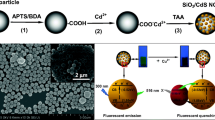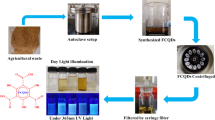Abstract
The surface of CdTe quantum dots (Q-dots) was modified with thioglycolic acid (TGA) and these Q-dots were then covalently conjugated to amino-functionalized silica-coated carbon dots (C-dot@SiO2) via carbodiimide chemistry. The Q-dots form kind of “satellites” on the surface of the C-dot@SiO2 nanoparticles. The nanoparticle conjugates display dual emission (with peaks at 441 nm and 605 nm) under UV excitation and were further characterized by transmission electron microscopy, UV–vis absorption and FTIR spectroscopy. The C-dot@SiO2@Q-dots hybrid spheres are shown to represent a ratiometric fluorescent probe for Cu2+ in that the emission of the Q-dots is quenched by Cu2+, while the emission of the C-dots (which are coated with SiO2) is not quenched. The ratio of the fluorescence intensities at 441 and 655 nm is related to the concentration of Cu2+ in the range from 0.1 to 1.0 μM, with a 0.096 μM lower detection limit. The ratiometric probe was successfully applied to the determination of Cu2+ in (spiked) vegetable and fruit samples by the standard addition method, and recoveries ranged from 96.7 to 100.8 %.

Carbon dots were first coated with silica and then with CdTe quantum dots to give nanoparticles with an architecture of the type C-dot@SiO2@Q-dots. These are shown to be a viable ratiometric fluorescent probe for the detection of Cu(II).






Similar content being viewed by others
References
Miao X, Ling L, Cheng D, Shuai X (2012) A highly sensitive sensor for Cu2+ with unmodified gold nanoparticles and DNAzyme by using the dynamic light scattering technique. Analyst 137(13):3064–3069
Yu M, Shi M, Chen Z, Li F, Li X, Gao Y, Xu J, Yang H, Zhou Z, Yi T, Huang C (2008) Highly sensitive and fast responsive fluorescence turn-on chemodosimeter for Cu2+ and its application in live cell imaging. Chem Eur J 14(23):6892–6900
Zong J, Yang X, Trinchi A, Hardin S, Cole I, Zhu Y, Li C, Muster T, Wei G (2014) Carbon dots as fluorescent probes for “off-on” detection of Cu2+ and L-cysteine in aqueous solution. Biosensor Bioelectron 51:330–335
Li F, Wang J, Lai Y, Wu C, Sun S, He Y, Ma H (2013) Ultrasensitive and selective detection of copper (II) and mercury (II) ions by dye-coded silver nanoparticle-based SERS probes. Biosens Bioelectron 39(1):82–87
Liu J, Lu Y (2007) Colorimetric Cu2+ detection with a ligation DNAzyme and nanoparticles. Chem Commun (46):4872–4874
Jung HS, Kwon PS, Lee JW, Kim JI, Hong CS, Kim JW, Yan S, Lee JY, Lee JH, Joo T, Kim JS (2009) Coumarin-derived Cu2+ −selective fluorescence sensor: synthesis, mechanisms, and applications in living cells. J Am Chem Soc 131(5):2008–2012
Hao Y, Liu L, Long Y, Wang J, Liu Y-N, Zhou F (2013) Sensitive photoluminescent detection of Cu2+ in real samples using CdS quantum dots in combination with a Cu2+ −reducing reaction. Biosens Bioelectron 41:723–729
Li H, Huang X-X, Kong D-M, Shen H-X, Liu Y (2013) Ultrasensitive, high temperature and ionic strength variation-tolerant Cu2+ fluorescent sensor based on reconstructed Cu2+ −dependent DNAzyme/substratecomplex. Biosens Bioelectron 42:225–228
Su L, Shu T, Wang Z, Cheng J, Xue F, Li C, Zhang X (2013) Immobilization of bovine serum albumin-protected gold nanoclusters by using polyelectrolytes of opposite charges for the development of the reusable fluorescent Cu2+ −sensor. Biosens Bioelectron 44:16–20
Wang Y-Q, Zhao T, He X-W, Li W-Y, Zhang Y-K (2014) A novel core-satellite CdTe/Silica/Au NCs hybrid sphere as dual-emission ratiometric fluorescent probe for Cu2+. Biosens Bioelectron 51:40–46
Zhu A, Qu Q, Shao X, Kong B, Tian Y (2012) Carbon-dot-based dual-emission nanohybrid produces a ratiometric fluorescent sensor for in vivo imaging of cellular copper ions. Angew Chem 124(29):7297–7301
Ghaedi M, Ahmadi F, Shokrollahi A (2007) Simultaneous preconcentration and determination of copper, nickel, cobalt and lead ions content by flame atomic absorption spectrometry. J Hazard Mater 142(1):272–278
Tao G-H, Sturgeon R (1999) Sample nebulization for minimization of transition metal interferences with selenium hydride generation ICP-AES. Spectrochim Acta B At Spectrosc 54(3):481–489
Li X-A, Zhou D-M, Xu J-J, Chen H-Y (2007) In-channel indirect amperometric detection of heavy metal ions for electrophoresis on a poly (dimethylsiloxane) microchip. Talanta 71(3):1130–1135
Rahman MA, Won M-S, Shim Y-B (2003) Characterization of an EDTA bonded conducting polymer modified electrode: its application for the simultaneous determination of heavy metal ions. Anal Chem 75(5):1123–1129
Zhang S, Wang Q, Tian G, Ge H (2014) A fluorescent turn-off/on method for detection of Cu2+ and oxalate using carbon dots as fluorescent probes in aqueous solution. Mater Lett 115:233–236
Durgadas C, Sharma C, Sreenivasan K (2011) Fluorescent gold clusters as nanosensors for copper ions in live cells. Analyst 136(5):933–940
Wang H-H, Xue L, Qian Y-Y, Jiang H (2009) Novel ratiometric fluorescent sensor for silver ions. Org Lett 12(2):292–295
Yao J, Zhang K, Zhu H, Ma F, Sun M, Yu H, Sun J, Wang S (2013) Efficient ratiometric fluorescence probe based on dual-emission quantum dots hybrid for on-site determination of copper ions. Anal Chem 85(13):6461–6468
Zhang K, Zhou H, Mei Q, Wang S, Guan G, Liu R, Zhang J, Zhang Z (2011) Instant visual detection of trinitrotoluene particulates on various surfaces by ratiometric fluorescence of dual-emission quantum dots hybrid. J Am Chem Soc 133(22):8424–8427
Yang Y, Ji S, Zhou F, Zhao J (2009) Synthesis of novel bispyrene diamines and their application as ratiometric fluorescent probes for detection of DNA. Biosens Bioelectron 24(12):3442–3447
Su T, Zhang Z, Luo Q (2012) Ratiometric fluorescence imaging of dual bio-molecular events in single living cells using a new FRET pair mVenus/mKOκ-based biosensor and a single fluorescent protein biosensor. Biosens Bioelectron 31(1):292–298
Li P, Fang L, Zhou H, Zhang W, Wang X, Li N, Zhong H, Tang B (2011) A new ratiometric fluorescent probe for detection of Fe2+ with high sensitivity and its intracellular imaging applications. Chem Eur J 17(38):10520–10523
Wu H, Mi C, Huang H, Han B, Li J, Xu S (2012) Solvothermal synthesis of green-fluorescent carbon nanoparticles and their application. J Lumin 132(6):1603–1607
Bao L, Zhang ZL, Tian ZQ, Zhang L, Liu C, Lin Y, Qi B, Pang DW (2011) Electrochemical tuning of luminescent carbon nanodots: from preparation to luminescence mechanism. Adv Mater 23(48):5801–5806
Yang Y, Chen O, Angerhofer A, Cao YC (2006) Radial-position-controlled doping in CdS/ZnS core/shell nanocrystals. J Am Chem Soc 128(38):12428–12429
Wang J, Chen G, Jiang H, Li Z, Wang X (2013) Advances in nano-scaled biosensors for biomedical applications. Analyst 138(16):4427–4435
Zhu S, Meng Q, Wang L, Zhang J, Song Y, Jin H, Zhang K, Sun H, Wang H, Yang B (2013) Highly photoluminescent carbon dots for multicolor patterning, sensors, and bioimaging. Angew Chem 125(14):4045–4049
Jin SH, Kim DH, Jun GH, Hong SH, Jeon S (2013) Tuning the photoluminescence of graphene quantum dots through the charge transfer effect of functional groups. ACS Nano 7(2):1239–1245
Tetsuka H, Asahi R, Nagoya A, Okamoto K, Tajima I, Ohta R, Okamoto A (2012) Optically tunable amino-functionalized graphene quantum dots. Adv Mater 24(39):5333–5338
Hu S, Tian R, Dong Y, Yang J, Liu J, Chang Q (2013) Modulation and effects of surface groups on photoluminescence and photocatalytic activity of carbon dots. Nanoscale 5(23):11665–11671
Jing L, Yang C, Qiao R, Niu M, Du M, Wang D, Gao M (2009) Highly fluorescent CdTe@ SiO2 particles prepared via reverse microemulsion method. Chem Mater 22(2):420–427
Bagwe RP, Hilliard LR, Tan W (2006) Surface modification of silica nanoparticles to reduce aggregation and nonspecific binding. Langmuir 22(9):4357–4362
Shi Y, Chen Z, Cheng X, Pan Y, Zhang H, Zhang Z, Li C-W, Yi C (2014) A novel dual-emission ratiometric fluorescent nanoprobe for sensing and intracellular imaging of Zn 2+. Biosens Bioelectron 61:397–403
Feng C, Shen Z, Li Y, Gu L, Zhang Y, Lu G, Huang X (2009) PNIPAM-b-(PEA-g-PDMAEA) double-hydrophilic graft copolymer: synthesis and its application for preparation of gold nanoparticles in aqueous media. J Polym Sci Part A: Polym Chem 47(7):1811–1824
Wang F, Xie Z, Zhang H, Liu CY, Zhang YG (2011) Highly luminescent organosilane functionalized carbon dots. Adv Funct Mater 21(6):1027–1031
Dong Y, Wang R, Li G, Chen C, Chi Y, Chen G (2012) Polyamine-functionalized carbon quantum dots as fluorescent probes for selective and sensitive detection of copper ions. Anal Chem 84(14):6220–6224
Koneswaran M, Narayanaswamy R (2009) L-Cysteine-capped ZnS quantum dots based fluorescence sensor for Cu2+ ion. Sensors Actuators B Chem 139(1):104–109
Zhang J, Li B, Zhang L, Jiang H (2012) An optical sensor for Cu (II) detection with upconverting luminescent nanoparticles as an excitation source. Chem Commun 48(40):4860–4862
Gattás-Asfura K M, Leblanc R M (2003) Peptide-coated CdS quantum dots for the optical detection of copper (II) and silver (I). Chem Commun (21) 2684–2685
Acknowledgments
This work was supported by a grant from the Two-Way Support Programs of Sichuan Agricultural University (Project No.03570113), the Education Department of Sichuan Provincial, PR China (Grant Nos. 13ZA0255).
Author information
Authors and Affiliations
Corresponding authors
Additional information
The authors wish it to be known that, in their opinions, Hanbing Rao and Wei Liu should be regarded as joint First Authors.
Electronic supplementary material
Below is the link to the electronic supplementary material.
ESM 1
(DOC 246 kb)
Rights and permissions
About this article
Cite this article
Rao, H., Liu, W., Lu, Z. et al. Silica-coated carbon dots conjugated to CdTe quantum dots: a ratiometric fluorescent probe for copper(II). Microchim Acta 183, 581–588 (2016). https://doi.org/10.1007/s00604-015-1682-6
Received:
Accepted:
Published:
Issue Date:
DOI: https://doi.org/10.1007/s00604-015-1682-6




